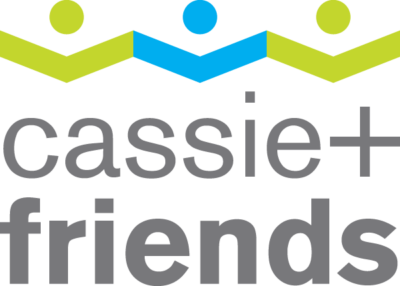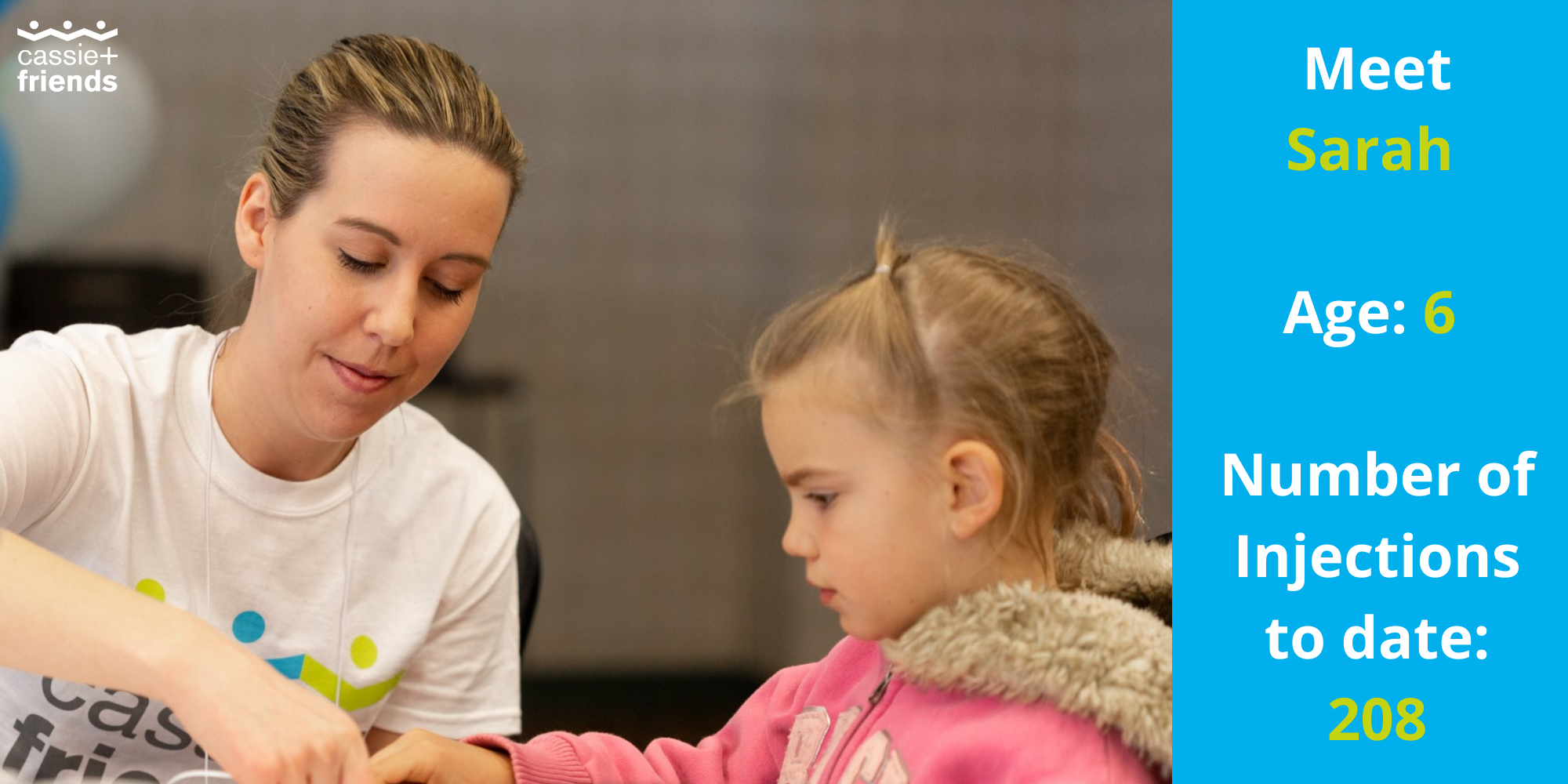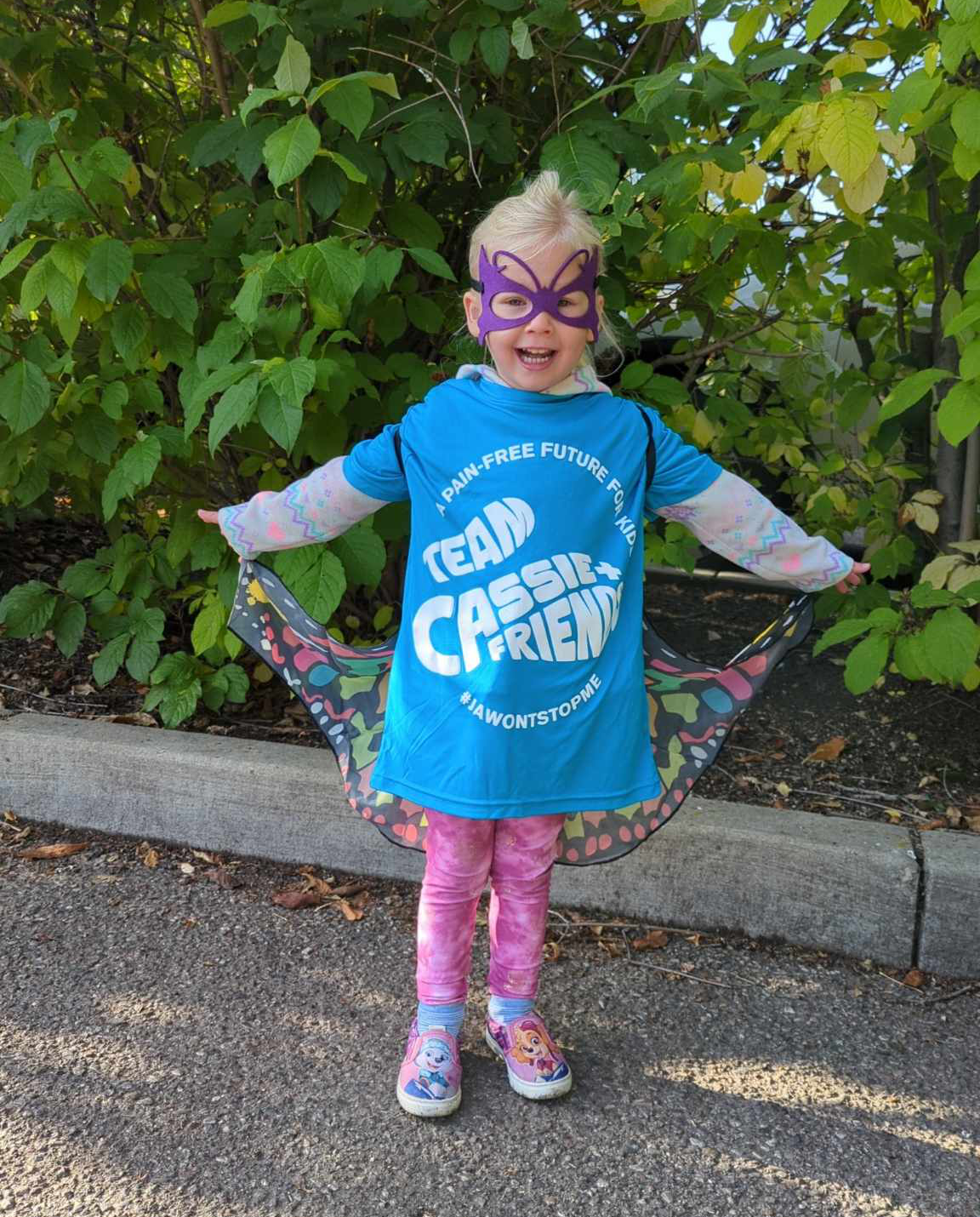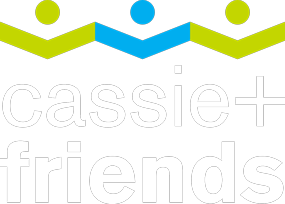Building a New Support Program for At-Home Injections & Needle Fears
A little nervous about needles? Let’s be honest – most of us are!
In fact 63% of kids and 50% of adolescents have a fear of needles.
But having to give your child an injection is a new experience altogether and one that often comes with its own kind of nervousness and anxiety. At Cassie + Friends, we are committed to developing new resources that empower families to navigate the difficulties of administering medication injections on their own.
Sign up for our newsletter to receive information on upcoming Injection Support sessions and more!
“I still don’t sleep well. A mother’s worry can take over your whole life. It affects me every day. Knowing this disease is in her. Having to – by my own hand – inject her with medicine. Having to sit there while she’s poked at for her routine bloodwork. Most of our lives revolve around this now and I’ve had to become a nurse overnight. Learning about these drugs, how to give needles, how to cope. It has been a very rough couple of years for us so far and unless you go through this and live this life no one can truly understand your pain.”
“Injection support is an exceptional service. When my daughter was diagnosed with JDM she had to submit to bloodwork every 4 weeks, IVIG infusions every 4 weeks, biologic infusions every 5 weeks and the worst of all, for her, Methotrexate (MTX) injections every week. Because the MTX injections made her so sick, she began to have anticipatory nausea days before her injection. She could no longer see the MTX bottle, stand the smell of the alcohol wipes nor talk about any of the injection process because it made her sick. No one else has any idea what these children with rheumatological diseases have to go through.”
Taking JA Medications by Injection
You may also have a medication that can be injected directly into your joint. This is called a joint injection or intra-articular injection.
And, there are likely other instances where you will encounter needles such as blood draws, vaccinations and other testing and procedures.
With the help of our community and healthcare partners, we’ve curated go-to tools and resources below that can help make the injection and needle experience easier for both you and your child and ensure that medication is delivered on time!
Video Resources
“Prior to the session, I was struggling with feeling defeated and lost in what our next steps could be. As I listened, I felt renewed energy and ideas coming through the explanations and plans/approaches that were communicated. It was not overwhelming but rather something I could resonate with, grasp and already see how we can apply it here at home with our daughter and myself too. I am actually looking forward to trying out the ladder plan and having those steps for us. Thank you!”
Injections 101 Webinar
In this webinar we hear from:
- A BC Patient and Parent duo, Caden and Colleen Castonguay
- Nicole Johnson, Pediatric Rheumatologist at Alberta Children’s Hospital
- Lynne Broderick, PR nurse at IWK Health
- Katie Birnie, Psychologist at Alberta Children’s Hospital and Assistant Scientific Director at Solutions for Kids in Pain (SKIP)
Écoutez l’enregistrement du webinaire en Français ici.
Intro/Welcome by Jennifer Wilson – 00:00
Jennifer Introduces Colleen and Caden – 07:00
Colleen and Caden Castonguay reflect on personal experiences with Injections – 07:30
Jennifer thanks Colleen and Caden and introduces Dr. Johnson – 18:00
Dr. Johnson explains the medical perspective on injections (trigger warning: images of needles) – 20:00
Jennifer thanks Dr. Johnson and introduces Lynne – 33:00
What to expect after the medication is prescribed with Lynne Broderick – 35:00
Jennifer thanks Lynne and introduces Dr. Birnie – 42:00
Strategies to make injections less anxiety-inducing with Dr. Birnie – 44:00
Jennifer thanks Dr. Birnie and all speakers, introduces Julie and starts the Q&A section – 1:09:00
Live Q&A 01:11:00 (46)
How can I know if my child’s resistance is needle phobia, fear of needle pain, or fear of the way the medication makes them feel? – 01:12:00
When did you recognize that you needed to reach out for more help regarding injections? – 1:13:00
How do you know when to look for alternatives for injections, such as oral medications? How do you work with your healthcare professional to achieve that? – 1:14:00
Julie talks about her personal experiences and the resource she has created for the injection process (which will be posted on the Cassie + Friends website) – 1:16:00
What are the experiences like with Hulio or Amgevita? (bad experiences with Humira autoinjector) – 1:20:00
What can be done at infusions if they are having trouble keeping the vein open? – 1:23:00
Do you have any position recommendations for 5-9-year-olds given that we have 2 adults in the home? – 1:25:00
Are there any issues with doing the methotrexate injection in the same place weekly? – 1:28:00
Besides bribery, what tactics can I use to get my child to take their injections? – 1:31:00
Thank you and closing remarks by Jennifer Wilson – 1:33:00
Tools + Strategies For Managing Needle Fears
In this workshop you will learn about:
- What is needle fear?
- Tools to help with low to medium levels of fear
- Strategies to manage pain and fainting from needles
- Tools to help with high levels of fear (facing fears!)
- How to manage possible anticipatory nausea when practicing facing fears of needles?
- Click here to download the Conquering Needle Fears Plan Template.
What’s your Injection Routine?
Young adult patient, Julie Beausoleil, has been doing self-injections with her JIA medication since she was in her early teens. In this video, she walks us through her at-home injection routine and shares some helpful tips when it comes to preparing yourself for your medication.
How-to: Adalimumab Injections Tutorial
We’ve teamed up with C+F parent leader and pharmacist, Jennifer Bessey to show you how to use the auto-injecting pre-filled pens with the medications: Humira (biologic), Hulio (biosimilar), Amgevita (biosimilar) as well as how to use a pre-filled syringe.
Managing Needle Pain: Tools Available to Your Family
How To Use A Buzzy Bee For Injections + Needle Pokes
Buzzy Bee is a tool that can help ease pain from medication injections, blood draws, and other needle pokes. In this video, you’ll learn how to use a Buzzy unit for stomach and leg injections in children and youth with rheumatic disease.
We’d like to express our gratitude to Associated Health Systems and PainCare Labs for their support in creating this video and providing Buzzy Units to the childhood rheumatic disease community in Canada.
Numbing Creams
Numbing cream helps to reduce your child’s pain during needle procedures like blood draws and injections. There are several different types of numbing cream, and each type requires a different specific time to take effect. Two common numbing creams used in Canada are EMLA and Zensa. While they differ in some ingredients, both contain the active ingredient lidocaine, which creates the numbing sensation, but just at differing concentrations. Zensa contains only lidocaine at a 5% concentration. EMLA is a combination product of prilocaine 2.5% and lidocaine 2.5%. Always confirm which type of numbing cream you are using to ensure you are leaving it on your child’s skin for the recommended waiting time.
Getting started with Injections:
No one truly looks forward to giving themselves, or their child, a needle. So it’s perfectly normal to feel anxious at first. This guide from AbbVie contains valuable information from doctors, nurses and pain specialists, to help make your entire injection process as smooth and comfortable as possible.
Getting started with needle pokes:
Needle pokes are one of the most common sources of pain for children seeking emergency medical care. Needle pokes may be used during healthcare visits to collect blood, deliver medication and fluids, or to numb certain body parts while stitching, for example. This video provides information about needle pokes and useful tips for parents and families who have a child that may require a needle poke.
SOURCE: This video was created through a collaboration between ECHO Research (University of Alberta), TREKK, and ARCHE (University of Alberta). Funding was provided by the Networks of Centres of Excellence and the Stollery Children’s Hospital Foundation through the Women and Children’s Health Research Institute.
Absolutely! Our friends at TREKK have put together this infographic to guide you through helping your child with a needle poke at every age. It also includes information on when/why they might need to get a needle poke, distraction techniques, and other tips!
There are many things that can be done to reduce anxiety about receiving needles. For some parents, this means coming up with a coping plan i.e. using distraction techniques, giving the child a sense of control by offering options (i.e., where the injection goes, look away, using numbing cream). If you find that you need support with this, you can talk to your rheumatologist or nurse about additional supports that might be helpful (e.g., child psychologists with expertise in this area). They can help your child learn coping strategies, come up with a gradual exposure plan, and work with you on some parenting support strategies that can be helpful.
You can also check out these guides:
Fear of needles is very common in children and adults. All children get needles through their regular immunizations. Those with medical illnesses or problems will need to get even more needles for injections or blood work. Most children and adults are able to overcome their fears, and it does not stop them from getting necessary immunizations, injections or blood work.
But if the fear is so great that it stops that person from getting needles, then it may be a condition known as ‘needle phobia’.
‘Needle phobia’ is a type of specific phobia. Its main features include:
- Marked and persistent fear of needles that is excessive or unreasonable, cued by the presence or anticipation of needles.
- Exposure to needles almost invariably provokes immediate anxiety.
- Situations involving needles are avoided or are endured with intense anxiety or distress.
- The avoidance, fear and distress around needles interfere significantly with the person’s life.
Learn more about the causes, experience treatment of needle phobia here!
In addition to the guides available on this page, you can hear from young adults in our community who shared their experience coping with needle phobia during our Virtual Youth Panel (Skip to 59:51).
Some children have also found it helpful to watch a demonstration of a needle. To help other kids learn about the process of getting an IV, 8-year-old Charlotte Sangers made this video of her stuffy named Giraffy getting his medication!
We chatted with three young adults in our community to learn about their experiences with self-injections. Here’s what they had to say:
Graeme: I started self-injecting methotrexate when I was 16, after 9 months in remission without any medication. The struggle was twofold: one, there was the idea of sticking a sharp object into my body and two, learning how to give myself injections meant facing the fact that I wasn’t well, and I would not be getting better for the foreseeable future.
My rheumatologist arranged appointments with a couple of nurses to help practice. We started on stress balls, which helped with the mechanics of using the syringe and needle. Then, I would go in every week and get feedback from them while I injected myself. Because I had to focus on the pain of the needle and the task at hand, I found it easier to distract myself from the nausea I associated with the medication.
That’s another thing: I found it hard to inject myself because there’s that initial pain when the needle goes in, and my reaction was to instantly pop the needle back out! Then I had to restart. I got in the habit of going slowly — I would take 5-10 seconds to get the needle in (my Dad used to take half a second).Self-injecting ultimately made it easier for me to manage my stress and nausea for methotrexate because I had to focus when I took it and I was in control.
Kelsey: I did my own injections from the moment I was diagnosed at age 14. I personally felt like this increased my independence and allowed me to travel, go to sleepovers etc. without concern for managing my medications.
Manahil: I switched to injections in high school and started regaining movement in the two fingers that were previously stiff. Injections were hard for me to get through but my parents would have me smell an orange peel while they gave me the injection as the smell is very pungent and instead of focusing on the injection I focused on the smell. If orange peels were not available they would have me eat a candy! In short, my parents were able to distract me from the discomfort of the injection and my condition became more stable a few months later as a consequence of the injections.
Looking for more “self-injection” content? Young adult patient, Julie Beausoleil, has been doing self-injections with her JIA medication since she was in her early teens. In this video, she walks us through her at-home injection routine and shares some helpful tips when it comes to preparing yourself for your medication.
Additional Resources
• Taking JA Medications by Injection
In this article from our friends at SickKids, you can learn more about the different types of injections, how they are administered, giving self-injections and tips for remembering to take your medication
A little nervous about needles? Let SuperMeg help you become a Pain Champion! Through the Meg Foundation, your child can create their very own plan to make their next needle poke a lot more comfortable, and a lot less scary!
• The Conversation: How to help if your child is afraid of a medical procedure
This article touches on exposure-based therapy, facing fears and troubleshooting when it comes to fears about a medical procedure.
• AboutKids Health: The Comfort Promise
Experts from Sick Kids Hospital share an entire hub of information on a range of evidence-based approaches to ease the pain of needle pokes for your child.
• Needle Pain and Anxiety Management Resources
Our session partners at Solutions for Kids in Pain (SKIP) have created a comprehensive list of resources including information for the whole family and for health professionals.
• Changing the Way Kids Remember Needle Pain
“Once pain is over, it’s not over.”
Pain creates memory, but memory is pliable and changeable. We are learning ways to harness and positively reframe children’s pain memories to be more accurate and positive. We can improve children’s future pain outcomes by pivoting the ways parents reminisce with their children about painful events. By choosing to talk about a painful experience in a positive way, you can change your child’s memory of it to be more positive too. Check out the graphic below for a powerful combination of tips.
Injections aren’t the only method of treatment causing fears! This resource from the Children’s Hospital of Eastern Ontario and the University of Calgary will help with swallowing pills and medications.
• Making a Plan to Conquer Needle Fears and Needle Exposure Resources:
When it comes to tackling needle fears, it may be helpful to make a plan with your child to make the procedure less scary and handle to process in small steps.
This resource provides an example plan and Needle-Related Situations for Exposures to help you and your child conquer needle fears right at home. This document also provides a list of other information and needle fear resources.
Click here to download the “Plan Template” for conquering needle fears and check out more resources!
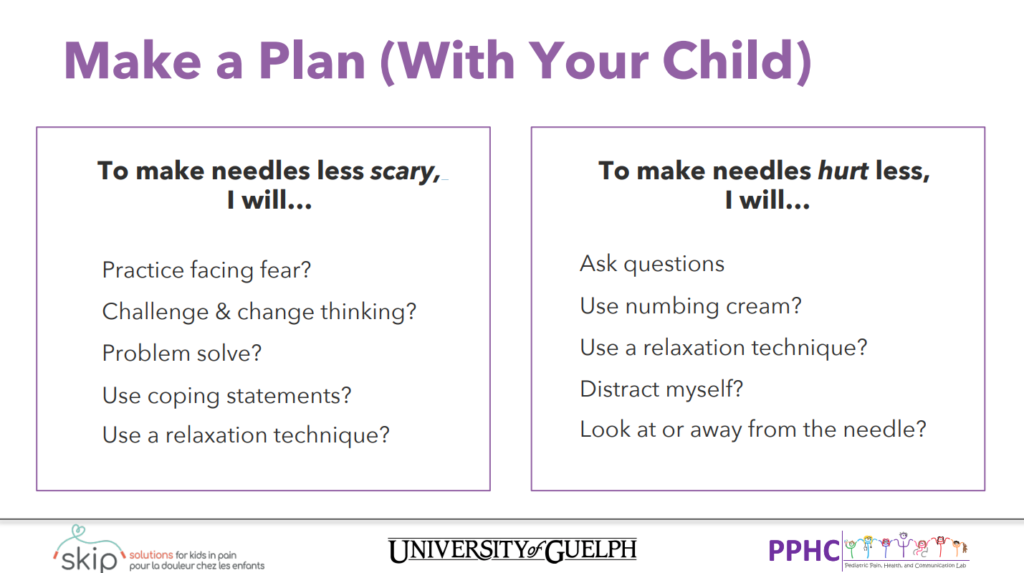
real injection stories from our community
Bella, Buzzy & a Beautifully Written Letter
Bella is turning 7 this year and while [...]
Lily’s Journey to Diagnosis, Methotrexate, and Finding A Community of Support
Meet Lily. One morning, at the young age [...]
OPT-JIA Premedication Trial
When I first heard of the medication [...]
